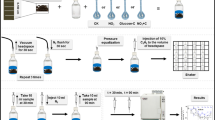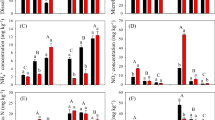Abstract
In a 2-year field study, denitrification loss was measured from an irrigated sandy-clay loam under cotton receiving urea-N at 158–173 kg ha–1. An acetylene inhibition-soil core method was employed for the direct measurement of denitrification, considering also the N2O entrapped in the soil. Taking into account the N2O evolved from soil cores and that entrapped in the soil, a total of 65.7 kg N ha–1 and 64.4 kg N ha–1 was lost due to denitrification during the 1995 and 1996 cotton-growing seasons, respectively. Most (>70%) of the denitrification loss occurred during June–August, a period characterized by high soil temperatures and heavy monsoon rains. On average, 35% of the denitrification-N2O was found entrapped in the soil and the amount of entrapped N2O was significantly correlated with head space N2O concentration and with water-filled pore space. 15N-balance during the 1996 growing season revealed a loss of 71.8 kg N ha–1. It was concluded that a substantial proportion of the fertilizer-N applied to irrigated cotton is lost under the semiarid subtropical climatic conditions prevailing in the Central Punjab region of Pakistan and that denitrification is the major N loss process under irrigated cotton in this region.
Similar content being viewed by others
Author information
Authors and Affiliations
Additional information
Received: 8 March 1999
Rights and permissions
About this article
Cite this article
Mahmood, T., Ali, R., Sajjad, M. et al. Denitrification and total fertilizer-N losses from an irrigated cotton field. Biol Fertil Soils 31, 270–278 (2000). https://doi.org/10.1007/s003740050656
Issue Date:
DOI: https://doi.org/10.1007/s003740050656




